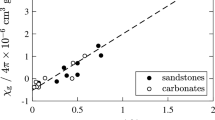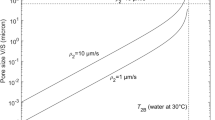Abstract
We report the application of proton nuclear magnetic resonance (NMR) imaging to the measurement of water content distributions in Lépine limestone, a typical constructional stone. The method is used to observe the kinetics of the absorption of water into this material by capillarity. The water content distributions are consistent with the predictions of unsaturated flow theory. The hydraulic diffusivity of Lépine stone is found to be an approximately exponential function of the water content, in agreement with experimental data on other porous materials. The best estimate of the diffusivity function is D (m2s−1) = 6.3 × 10−9 exp (4.90θ r), whereθ r is the normalized volumetric water content. The sorptivity estimated from NMR data is in close agreement with the directly measured value (1.00 mm min−1/2). NMR imaging methods appear promising as a non-destructive and rapid laboratory means of determining moisture distributions, especially for the purpose of accurate measurement of the capillary transport properties of porous materials.
Resume
On décrit l’application de l’imagerie de résonance magnétique nucléaire (RMN) à la mesure de distributions de teneur en eau dans le calcaire Lépine, pierre de construction type. On présente les résultats d’une expérience où l’eau est absorbée librement par capillarité de l’extrémité d’une barre rectangulaire. On utilise l’imagerie RMN pour contrôler la vitesse d’absorption de l’eau. On obtient, par l’analyse des images, les distributions à l’intérieur de l’échantillon en fonction du temps.
Les distributions de teneur en eau concordent avec l’application de la théorie de l’écoulement en milieu non saturé. La diffusivité hydraulique et le coefficient de sorption se calculent à partir des profiels d’absorption d’eau. Le coefficient de diffusion de la pierre de Lépine est une fonction approximativement exponentielle de la teneur en eau, conforme aux données expérimentales des autres matériaux poreux. La meilleure estimation de la fonction de diffusion est D (m2s−1) = 6.3 × 10−9 exp (4.90θ r), oùθ r est la teneur en eau volumétrique normalisée.
Le coefficient de sorption évaluée à partir des données RMN concorde tout à fait avec la mesure directe (1,00 mm min−1/2). Les méthodes d’imagerie RMN semblent prometteuses en tant que technique de laboratoire non-destructive et rapide pour déterminer les distributions d’humidité, et en particulier, mesurer avec précision les propriétés de mouvement d’eau par capillarité de matériaux poreux.
Similar content being viewed by others
References
‘Outline of a national plan on high-performance concrete: report on the NIST/ACI Workshop, May 16–18, 1990’, NISTIR 4465 (US Department of Commerce, 1990).
Chaddock, J. B. and Todorovic, B. (eds), ‘Heat and Mass Transfer in Building Materials and Structures’ (Hemisphere, New York, 1991).
Hall, C., ‘The water sorptivity of mortars and concretes: a review’,Mag. Concr. Res. 41 (1989) 51–61.
Kumaran, M. K. and Bomberg, M., ‘A gamma-spectrometer for determination of density distribution and moisture distribution in building materials’, in Proceedings of International Symposium on Moisture and Humidity, Washington, DC, April 1985 (Instrument Society of America, Research Triangle Park, NC, USA, 1985) pp. 485–490 (NRCC DBR paper 1302).
Kumaran, M. K., ‘Gamma-spectroscopic determination of moisture distribution in medium-density glass fibre insulation’, NRCC Building Research Note 242 (1986).
Nielsen, A. F., ‘Free water intake of cellular concrete and bricks measured by gamma ray attenuation’, Report No. 41 (Thermal Insulation Laboratory, Technical University of Denmark, Copenhagen, 1976).
Daïan, J.-F., ‘Condensation and isothermal water transfer in cement mortar: Part I—pore size distribution, equilibrium water condensation and imbibition’,Transp. Porous Media 3 (1988) 563–589.
Prazák, J., Tywoniak, J., Peterka, F. and Slonc, T., ‘Description of transport of liquid in porous media—a study based on neutron radiography data’,Int. J. Heat Mass Transfer 33 (1990) 1105–1120.
Quénard, D. and Sallée, H., ‘A gamma-ray spectrometer for measurement of the water diffusivity of cementitious materials’ in ‘Pore Structure and Permeability of Cementitious Materials’, edited by L. R. Roberts and J. P. Skalny, MRS Symposium Series No. 137 (Materials Research Society Pittsburgh, 1989).
Gummerson, R. J., Hall, C., Hoff, W. D., Hawkes, R., Holland, G. N. and Moore, W. S., ‘Unsaturated water flow within porous materials observed by NMR imaging”,Nature 281 (1979) 56–57.
Hayashi, K., ‘NMR imaging of advanced ceramics during the slip casting process’,J. Phys. D 21 (1988) 1037–1039.
Ackerman, J. L. and Ellingson, W. A. (eds), ‘Advanced Tomographic Imaging Methods for the Analysis of Materials’, MRS Symposium Proceedings No. 217 (Materials Research Society, Pittsburgh, 1991).
Fordham, E. J., Roberts, T. P. L., Carpenter, T. A., Hall, L. D., Maitland, G. C. and Hall, C., ‘Nuclear magnetic resonance imaging of simulated voids in cement slurries’,AIChEJ 37 (1991) 1895–1899.
Fordham, E. J., Horsfield, M. A., Hall, C. and Hall, L. D., ‘Low-contrast secondary imbibition in long rock cores’,Magn. Reson. Imaging 9 (1991) 803–808.
Hall, C., ‘Water transport in porous building materials—IV. The initial surface absorption and the sorptivity’,Building Envir. 16 (1981) 201–207
RILEM, ‘CPC 11.1 Absorption of water by immersion; CPC 11.2 Absorption of water by capillarity’,Mater. Struct. 7 (1974) 291–297.
Chen, C.-N. and Hoult, D. I., ‘Biomedical Magnetic Resonance Imaging Technology’ (Hilger, Bristol, UK, 1989).
Edelstein, W. A., Hutchison, J. M. S., Johnson, G. and Redpath, T., “Spin-warp NMR imaging and application to human whole-body imaging”,Phys. Med. Biol. 25 (1980) 751–756.
Honeyborne, D. B., ‘The Building Limestones of France’ (HMSO, London, 1982).
Brutsaert, W., ‘The concise formulation of diffusive sorption of water in a dry soil’,Water Resources Res. 12 (1976) 1118–1124.
Idem, ‘Universal constants for scaling the exponential soil water diffusivity?’,ibid. 15 (1979) 481–483.
Kalimeris, A. N. and Hall, C., ‘Absorption and desorption of water by porous building materials’, in ‘Materials Science and Restoration’, edited by F. H. Wittmann (Lack und Chemie, Stuttgart, 1983).
Kalimeris, A. N., ‘Water flow processes in porous building materials’, PhD thesis, University of Manchester (1984).
Wilson, M. A., Hoff, W. D. and Hall, C., ‘Water movement in porous building materials—X. Absorption from a small cylindrical cavity’,Building Envir. 26 (1991) 143–152.
Guillot, G., Trokiner, A., Darasse, L., Dupas, A., Ferdossi, F., Kassab, G., Hulin, J.-P., Rigord, P. and Saint-Jalmes, H., ‘NMR imaging applied to various studies of porous media’,Magn. Reson. Imaging 9 (1991) 821–825.
Author information
Authors and Affiliations
Rights and permissions
About this article
Cite this article
Carpenter, T.A., Davies, E.S., Hall, C. et al. Capillary water migration in rock: process and material properties examined by NMR imaging. Materials and Structures 26, 286–292 (1993). https://doi.org/10.1007/BF02472950
Issue Date:
DOI: https://doi.org/10.1007/BF02472950




